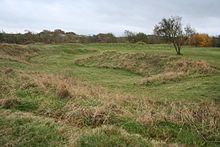The Bull Ring
 | |
| Location | Dove Holes |
|---|---|
| Region | Derbyshire, England |
| Coordinates | 53°18′2.5″N 1°53′3.92″W / 53.300694°N 1.8844222°W |
| Type | Henge (Class II) |
| History | |
| Periods | late Neolithic |
| Site notes | |
| Condition | some damage |
| Official name | Bull Ring henge, oval barrow and bowl barrow |
| Designated | 26 November 1928[1] |
| Reference no. | 1011204 |
The Bull Ring is a Class II henge that was built in the late Neolithic period near Dove Holes in Derbyshire, England.[1]
It has coordinates 53°18′03″N 1°53′04″W / 53.300695°N 1.884423°W[2] (grid reference SK 0785 7823), and is National Monument number 23282. There are also two barrows about 20m away from the henge; one oval, one bowl.[1]
The henge consists of a large, circular
A single
A minor excavation was carried out in the west ditch in 1902 by Micah Salt; this reputedly discovered some pottery sherds and flint flakes, which have since been lost.[1] A trial excavation by Oxford University Archaeological Society in 1949 established that the ring has two entrances, and also provided information about the original size of the bank and ditch. However, it did not provide any evidence of stones on the site.[5] The excavation also turned up flint flakes, as well as a rim from a pottery food vessel.[1]
A third excavation was carried out in 1984 outside the south entrance, which found further flint flakes and pottery, several pits, and stakeholes of a fence following the henge bank, which are potentially original features of the henge.
The
See also
References
- ^ a b c d e f g h i Historic England. "Bull Ring henge, oval barrow and bowl barrow (1011204)". National Heritage List for England. Retrieved 15 February 2014.
- ^ "Bullring Henge at the Megalithic Portal". Retrieved 9 February 2006.
- ^ "The Bull Ring". Archived from the original on 26 November 2004. Retrieved 9 February 2006.
- ^ "Peak District Towns and Villages: Dove Holes". Retrieved 9 February 2006.
- .
- ^ Barnatt, J. (1988). "Excavations at the Bull Ring henge, Dove Holes, Derbyshire, 1984–85". Derbyshire Archaeological Journal. 108: 5–20.
- ^ Martin, L (7 November 2000). "The Bull Ring, Dove Holes, Derbyshire. Report on geophysical survey, September 2000". Retrieved 9 February 2006.
- "The Bull Ring". Megalithic Portal.
Further reading
- Andrew, W.J. (1905). "The Bull Ring: a stone circle at Dove Holes". Derbyshire Archaeological Journal. 27.
- Tristram, E. (1915). "The stone circle, known as the 'Bull Ring', at Dove Holes, and the mound adjoining". Derbyshire Archaeological Journal. 37.
